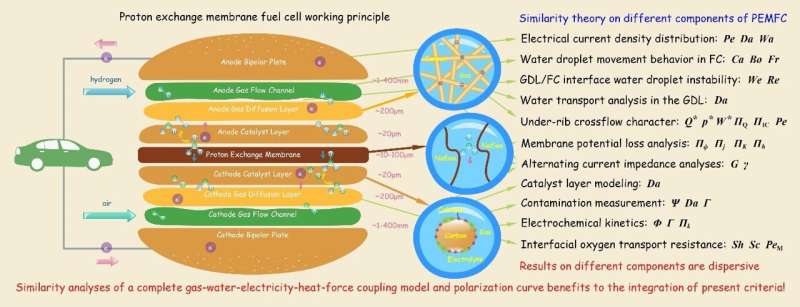Apples to apples: How similarity theory could boost fuel cell research

Globally, an ever-increasing number of research groups are focusing on technology related to the production of hydrogen, which is now widely accepted as the ultimate clean energy carrier. However, the conversion of hydrogen into a usable form of energy, such as electricity, is just as important. In this regard, proton exchange membrane fuel cells (PEMFCs) are currently our best bet.
The operating principle of PEMFCs is rather easy to grasp; a hydrogen oxidation reaction happens at the anode, an oxygen reduction reaction occurs at the cathode, and the only products are water and electricity. Nevertheless, in actual PEMFC implementations, one must also take into account a plethora of associated processes and technical aspects, such as material selection, thermofluidics, mechanics, and electrochemistry, to name a few. Thus, PEMFC research has skyrocketed over the last decade as scientists try to overcome all the challenges that appear in our path toward scalable and efficient PEMFC technology.
Unfortunately, the complexity and multi-faceted nature of PEMFC systems coupled with the surge in published articles has made it difficult to accurately gage the progress that is being made. In other words, the diversity of parameters involved in designing PEMFCs not only makes them a hard and time-consuming subject to study, but also renders quantitative comparisons between different implementations much harder. But what if there was a framework in which we could always compare apples to apples, i.e., we could compare studies using different parameters reliably, despite their methodological diversity?
In a review article recently published in Energy Storage and Saving, a team of researchers from Xi'an Jiaotong University, China, summarize recent efforts for adopting such a framework in PEMFC research: similarity theory. Also referred to as dimensionless analysis, similarity theory is based around describing a system using dimensionless parameters, which ideally encapsulate the relationships between a much higher number of input (dimensional) parameters. Using similarity theory, researchers can report on the results of PEMFC designs in such a way that other groups can seamlessly compare them with their own results. Moreover, instead of having to perform experiments where dozens of input parameters are varied one by one to assess their effect, similarity theory strives to find meaningful dimensionless relationships between these parameters and the output values, thus saving a lot during the experimentation phase.
The article presents a comprehensive review of how dimensionless analysis has been applied in PEMFC research, divided into four essential parts: flow channel or gas diffusion layer transport processes, the characteristics of membrane electrode assemblies, measurements of PEMFC contamination, and electrochemical kinetics. "The objective of our review was to highlight and analyze the benefits of similarity theory, including the derivation of a general law, reduction in testing efforts, ease of comparison between different studies, and the provision of guidance for scaling up experiments," highlights Professor Wen-Quan Tao, who led the team, "We want to motivate scientists to formulate dimensionless expressions of their PEMFC research to obtain more general and concise conclusions."
Although similarity theory has definitely found its way into PEMFC research, there is still much more work to be done to unlock its true potential. As detailed in the review, the total number of dimensionless criteria that have been derived thus far is quite high, and they tend to focus on different parts of PEMFC systems. Thus, researchers could really benefit from more integrated and dimensionless performance criteria derived from the differential equations for the complete processes in PEMFC instead of focusing only on single parts In the article, the team suggests a way in which this problem could be tackled through a subsequent hierarchical classification of criteria based on the immediate impact of a criterion on either the individual subprocesses or integrated performance.
Overall, it appears similarity theory could be a powerful approach to accelerate progress in PEMFC research. However, as Professor Tao remarks, much work still needs to be done: "Although similarity theory is an effective tool to derive general laws, our review indicates that none of the existing models for PEMFCs can achieve this objective, and further research pertaining to this aspect must be performed." Let us all hope similarity theory gets the attention it warrants so that high-performance PEMFCs make their way into tomorrow's clean energy technologies.
More information: Fan Bai et al, Application of similarity theory in the study of proton exchange membrane fuel cells: A comprehensive review of recent developments and future research requirements, Energy Storage and Saving (2021). DOI: 10.1016/j.enss.2021.09.001















